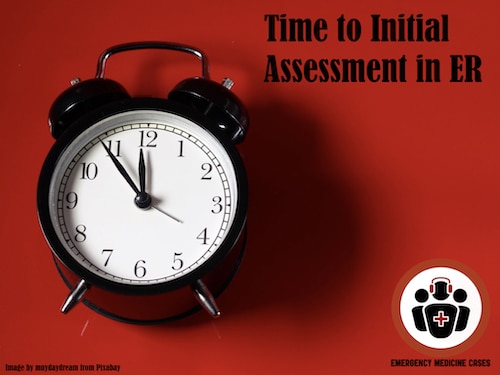By Dr. Howard Ovens, April 2015
As both an emergency director and a practising emergency physician, I believe it is the job of administrators to make the challenges of front line staff easier, not vice-versa. Clinicians are too busy taking care of patients to perform purely administrative chores. But one task that I would ask all emergency doctors to adopt is the step of recording the time of Physician Initial Assessment, or PIA times.
The time from arrival until they first see a physician is what most patients consider their ED wait time, and it is an important metric to report. Yes, it means one more small box to fill out in your charting, but it can be of huge benefit to doctors. Allow me to explain why….
Background
This issue came up a few weeks ago for me when I visited the province of Saskatchewan on behalf of the Canadian Association of Emergency Physicians to discuss the government’s ED overcrowding strategy with a panel of health officials and physicians. In some Saskatchewan EDs, the majority of physicians do not document PIA times on their charts routinely, and they object to doing so. The docs feel they are being asked to do administrative work when they are busy caring for patients.
Many of us write these times automatically and have never thought of it as a controversy, but that is not universally true, and it can be difficult to get docs who are not used to doing this to change their record-keeping practices.
In Ontario, where I practise and provide advice on policy issues to government, we introduced new requirements for reporting ED data as part of the Ontario ED wait time strategy. This four-year initiative was launched in April 2008, and through it hospitals were obliged to report PIA times. Some physicians objected at first. However, over time it became a routine task that almost everyone accepted — once they had experience with it and could see the logic behind it.
How recording PIA times benefits doctors
- Supporting fair compensation: I teach my staff and trainees that we take good care in diagnosis and treatment for the benefit of our patients, while we write good notes — i.e., document well — for, among many other reasons, our own benefit. Good documentation will support receiving fair compensation for our efforts. PIA times will be relevant to many fee codes in many jurisdictions. In Ontario, for instance, that includes supporting claims for premium hours (evenings, nights and weekends), claims for reassessment, etc. When we feel too busy to create an adequate record of our care, we are short-changing ourselves.
- Responding to complaints: Recording some crucial times, including PIA times, is part of best practices in medical documentation. PIA times are important in responding to many patient complaints —especially those related to waiting times. The sequence of events in a patient’s episode of care can often have important implications in medical legal cases, and the PIA time is an important part of the sequence. For example, was a high potassium level reported before or after the doctor saw the patient?
- Maintaining standards of care: Finally, as documenting this time is considered a generally accepted standard of care, failure to record it could reflect badly on you in a complaint or lawsuit where your overall integrity and adherence to standards of practice are being questioned. For instance, you might have difficulty answering a probing question from a lawyer, such as: “If you don’t record mandatory data elements on your charts, what other standard and required practices do you ignore, Doctor?”
A minimal ‘burden’
Making it your routine to take a few seconds for each case to write down the time that you started to see your patient will add (at most) a minute or two to the average shift. When we discharge a patient we can never predict what might occur subsequently; and if the care is reviewed because of a poor patient outcome, or because of your billing, or for a host of other reasons, good documentation will be your best ally. Recording PIA times will feel like a burden only until it becomes a habit, and then it will be no more a hassle than simply signing your charts.
For those of you who work in departments with electronic tracking systems (ED Information System, or EDIS) you may wish to explore the possibility of using the time stamp from when you assigned yourself a patient in the EDIS as a surrogate for the PIA time. To enable this requires generally good and consistent compliance across your emergency group at using the EDIS patient assignation function and co-operation from you hospital administration to capture and report these times. It may also require you to consider the appropriateness of a common practice: that is, assigning several patients at once to save time. Don’t do it unless you are fairly confident that each of the patients will be seen in fairly quick order.
In summary, wherever you work, and whether you work in a paper or electronic environment, recording PIA times should not be burdensome and is in your own best interest.





Leave A Comment